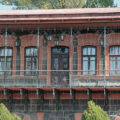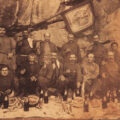- Балкон дома Дзитохцянов / The balcony of the Dzitokhtsyan house
In December 2023, the tradition of blacksmithing in the city of Gyumri was inscribed on the UNESCO’s Representative List of the Intangible Cultural Heritage of Humanity. Over the centuries, the creation of iron objects was a cultural feature of Armenian cities. In the mid-20th century, this craft all but disappeared. Today, Gyumri is the only place where urban blacksmithing has survived.
The city of crafts
Gyumri is Armenia’s second largest city and cultural capital. The city has existed for hundreds of years under different names. It was founded by the Cimmerians in the Middle Ages in an area that was then part of Persia. The heyday of blacksmithing began in Gyumri in the mid-19th century. The Russo-Turkish wars increased the population of the city, making it a stronghold of the Russian Empire.
Gyumri is popularly known as the “city of crafts”. To this day, many craftsmen work here, preserving the 19th century traditions. Blacksmiths enjoy a special status in Gyumri. They are called the “masters of masters” because they are the ones who make the tools for other craftsmen. Blacksmith workshops have blended into the modern urban environment and create true works of art.
Local tradition
Ordering handmade items from craftsmen has been and still is a Gyumri tradition. People go to craftsmen for gates, street lamps, window grilles, balcony railings and other metal objects. Forged items surpass factory-made objects in quality and aesthetics. Many of the city’s houses with a century-old history feature decorative elements created by the local blacksmiths.
- Кузнецы под знаменем гильдии / Blacksmiths under the guild’s banner
- Три поколения семейства Папоянов / Three generations of the Papoyan family
Dynasties of craftsmen
Today in several family-owned blacksmith workshops in Gyumri, the craft is passed down from generation to generation. Learning the traditional blacksmithing craft is a long and complex process. From an early age, boys help their fathers or grandfathers. Apprenticeships usually start at the age of 10-12. Before taking on a new apprentice, the master craftsman had to undergo a swearing-in ceremony, pledging to treat the apprentice as his own son and teach him all the tricks of the trade. Often the apprentice remained the craftsman’s assistant for many years. Only at the age of 20-22 was the apprentice allowed to perform some operations on his own. At 25, the apprentice became an independent craftsman. The Papoyan and Mnoyan families are among the oldest and best-known blacksmith dynasties in Gyumri. The Papoyan family have been practicing their craft for about 150 years. A photo of the great-grandfather showing him and other craftsmen under the banner of the city guild of blacksmiths is a cherished family relic.
Exotic patterns
Iron art in Gyumri is known for its high quality. Items feature plant, geometric, and bird motifs. In plant patterns, in addition to stems and leaves, there are also “lyres”, resembling a musical instrument. The unfolded peacock tail is the rarest of the bird ornaments. The patterns created by talented blacksmiths on urban decor elements help one feel the unique atmosphere of ancient Gyumri.
Ornamental iron work has always been the main specialization of blacksmiths in Gyumri. Houses are adorned with gates, grilles, balcony and staircase railings, metal grilles for porches, window frames, chandeliers, and candle holders. Combined with the buildings made of black and orange tuff,
these elements have shaped the city’s appearance. In the Soviet years, due to the rapid industrialization and the abolition of private property, traditional crafts began to decline. By the mid-20th century, blacksmithing in Armenia all but disappeared. Only in Gyumri do residents still use iron items in their everyday life. Today’s blacksmiths, many of whom are 5th or 6th generation master craftsmen, carefully preserve the tradition of urban blacksmithing and pass on their skills to their children.
Agasi Tadevosyan,
Candidate of Historical Science, leading research fellow, Institute of Archeology
and Ethnography of the National Academy of Sciences of Armenia




